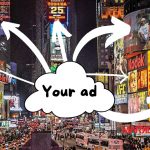As the digital era expands and continues to disrupt everything, how will the advertising and marketing industries keep up the pace?
We are seeing and hearing examples of disruptive innovation and digital transformation all around us daily.
However, what we really need to discuss is how we can make some sense of the ever-changing digital revolution; more importantly, how it is now augmenting our society and impacting the way we work and go about our day-to-day.

Noreen Sabrina Mohd Noor, Brand Communications Head at Malaysia Digital Economy Corporation (MDEC), is constantly addressing the digital challenge.
Being involved with many critical branding efforts for MDEC, she now shares how digital transformation is creating long-term positive impacts; specifically, for the advertising and marketing industries.
This not only includes current and upcoming digital disruptors, but also marketers can expect to see in the near future.
Just mention ‘digital nation’ and most would look to countries like Japan, South Korea, Estonia, Germany, and Singapore. What does it take to be a fully digital empowered country?
Besides next-gen infrastructure/services in place, enabling progressive and inclusive participation to galvanise people towards one vision is equally as critical. From experience, this is heavily dependent on constant and consistent communications and awareness.
If anything, Malaysia is well on its way to being digitally empowered as it has introduced various initiatives; they are now accelerating the transformation process on all fronts – the private sector, government, and general populace.
With broadband penetration now at record highs, 121.1% in 2018 versus 68.3% in 2014, it’s reflective of Malaysia’s innate growth potential.
Noreen, who is also APPIES Malaysia judge this year, shares her thoughts in this piece…
Digital Disruptors
Nearly every aspect of businesses and everyday life is seeing some level of digital disruption. However, probably none has experienced a massive an impact as what the advertising and marketing industries go through.
With various technological advancements and adoptions now taking place, trends such as consumer behaviour, platform preference, and media consumption are radically shifting.
My 80-year-old mum, who used to read the newspaper and check the 8pm News, now gets hourly updates; all that and more from push notifications on her smartphone. This is an example of how technology has changed her routine.
Thus, I have no doubt various industry verticals will look dramatically different within the next five years.
Thanks to the rise of next-gen innovations, users now expect processes to be seamless and pro-actively responsive.
Take for instance Estonia and South Korea – both implement their on-going digital evolution in ways that are uniquely theirs. Estonia was named ‘the most advanced digital society in the world’ by Wired; this title was to recognise the successful creation of an efficient, secure, and transparent public service platform; one that efficiently saved time and money.
The goal: to facilitate citizen interactions with the state via digital platforms.
South Korea, while similar in its results, takes on a different strategy. Like Estonia, it leaned heavily on public-private partnerships. However, its main execution differs – the current technology juggernaut of East Asia wanted to bring about a digital-focused future.
From the ground-up, the entire process pushed many organisations to change their business model and accelerate all digital adoption processes.
But, how did both countries push the message across that “digitisation is the way forward”? It all boils down to how receptive the public is.
With smartphones use and social media access now being more commonplace, most consumers are more open to embracing digital change. In the eyes of marketers, this trend is all about competing for people’s attention.
To avoid the trap of too much information, simply put – avoiding the ‘noise,’ advertising and marketing players must lead in digital adoption.
It’s not uncommon for a campaign to side-step the digital processes that Silicon Valley behemoths have put in place. It is essentially about assembling a variable campaign that will get the message to any audience group, via multiple platforms.
Even as the digital era enable more disruptions, marketers must always remember that clarity, adaptability, and scalability are important.
Going with the ‘one-size fits all’ approach is now the road to failure. Embracing digital only means showing true versatility. By understanding this, these industries will be a few steps closer to being properly future-proof.

Change is Innovation
Digital disruption, on many levels, is a positive force of change. Innovation is constantly progressive; this is more so for Malaysia as it continues to understand and adapt to the ever-changing landscape.
The changes we’re seeing now, they are all part of a larger shift.
Take for example, Instagram. It hadn’t been present 10 years back and, yet, it had surpassed 800 million active monthly users. Similarly, the rise of emerging technologies, such as artificial intelligence (AI), automation, and virtual reality will cause further disruptions.
Looking beyond marketing, even other sectors are undergoing change – like education, healthcare, and commercial operations. Disruption, through innovation, is all encompassing.
The convergence of AI, automation, and human creativity will – undoubtedly – transform various industries. The world is already beginning to see what’s possible. We are already in an era where schools no longer use blackboards for classes or see businesses arranging face-to-face meetings.
Everything is accessible by remote now and soon enough, there is the possibility of riding in cars that fly. All of these are empowered and enhanced via the constantly innovating technologies we now see and use.
In addition to being more personal, communication and media consumption will also feel more immersive. Most cities offer fully automated public services and financial institutions – such as in Estonia and South Korea.
This is now expanding rapidly within Malaysia as well.
Opportunity for Malaysia
Innovation is about disrupting the status quo and making things better – essentially, improving and enhancing processes. Marketers in the digital age must not be afraid to be the industry disruptor.
The Malaysian government is constantly pushing for digital transformation to ensure that no one is left behind. As is, there are on-going efforts in providing world-class infrastructure and developing a pool of tech talent.
Of course, right now stronger emphasis must also be enforced in policies and legislation. In doing so, various industries – advertising and marketing included – will have the means to innovate at scale.
Even as the world now goes through challenging times, consider them as opportunities to reap the full potential of digital transformation. Of course, there are those who will be helping to guide the way. MDEC, along with other key agencies, are poised to facilitate and support anyone who is keen to overcome the stagnant hurdle and make that digital leap.
MARKETING Magazine is not responsible for the content of external sites.









